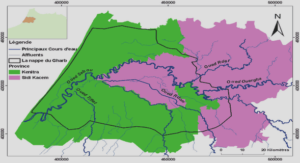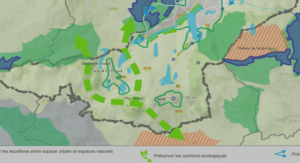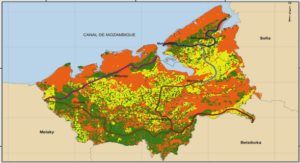Sommaire: Effets du benzothiadiazole sur l’induction des mécanismes de défense chez la tomate (Une étude protéomique comparative)
Chapter I: Introduction, working hypothèses and research objectives
1.1 Introduction
1.2 BTH as an efficient inducer of plant défense responses
1.2.1 The mode of action of BTH
1.2.2 The efficacy of BTH
1.3 Défense signalling pathways in plants
1.3.1 SA-mediated résistance
1.3.1.1 SA and the induction of ISR
1.3.1.2 SA biosynthesis
1.3.1.3 SA signalling in plants
1.3.2 JA-mediated résistance
1.3.2.1 The rôle of jasmonates in tomato défense
1.3.2.2 Jasmonate biosynthesis
1.3.2.3 Jasmonate signalling
1.3.3 Interacting défense pathways in planta
1.3.4 Intégration and coordination of défense responses
1.4 The « omics » expérimental approaches and the understanding of complex défense pathways in plants
1.4.1 The genomics approach
1.4.2 The proteomics approach
1.4.3 Proteomics as a complément to genomics
1.5 Research problematic
1.6 Goals, working hypothèses and research objectives
1.6.1 Working hypothesis
1.6.2 Objectives and methodological approach
1.6.2.1 Spécifie objectives
1.6.2.2 Some information on the SELDI TOF MS technology.
1.6.2.3 Some information on 2-DE based, classical proteomics
Chapter II A SELDI TOF MS procédure for the détection and monitoring of conflicting and synergistic défense responses in plants
2.1 Introductory remarks
2.2 Résumé
2.3 Abstract
2.4 Introduction
2.5 Materials and methods
2.5.1 Plant material and elicitor treatments
2.5.2 Leaf protein extraction and sample processing
2.5.3 SELDI TOF MS and data analysis
2.6 Results and discussion
2.6.1 Time-course effects of BTH on the leaf low-molecular-weight proteome
2.6.2 Differential impact of MeJA on spécifie BTH effects
Chapter III Modulation of the leaf proteome in tomato (Solanum lycopersicum) challenged with the synthetic elicitor benzothiadiazole
3.1 Introductory remarks
3.2 Résumé
3.3 Abstract
3.4 Introduction
3.5 Materials and methods
3.5.1 Plant material and elicitor treatments
3.5.2 Gene probes and northern blot analysis
3.5.3 Sample préparation and 2-DE
3.5.4 Image acquisition and data analysis
3.5.5 Protein identification
3.6 Results and discussion
3.6.1 Induction of Pin-ll and protein P4 synthesis in tomato Ieaves
3.6.2 BTH induces both SA-inducible and JA-inducible proteins in
tomato leaves
3.6.3 MeJA potentiates the inducing effects of BTH for several BTH-sensitive proteins
3.7 Conclusion
Chapter IV Conclusion and further perspectives
4.1 Conclusion
4.1.1 Objective 1
4.1.2 Objective 2
4.2 Confirmation of the working hypothèses
4.3 Future perspectives
Références
Extrait du mémoire effets du benzothiadiazole sur l’induction des mécanismes de défense chez la tomate (Une étude protéomique comparative)
Chapter I: Introduction, working hypothèses and research objectives
1.1 Introduction
Induced systemic résistance (ISR)1, or systemic acquired résistance (SAR), is an important component of a plant’s répertoire of disease résistance mechanisms referring to the systemic induction of défense reactions in planta.
The term SAR was originally used by Ross (1961a,b), who discovered that after inoculation of the lower leaves tobacco plants with the tobacco mosaic virus (TMV), the upper leaves acquired the state of résistance. During ISR, plants successfully resisting a pathogen become highly résistant to subséquent infection, not only to the original pathogen, but also to a variety of other pathogens (Navarre and Mayo, 2004). This type of résistance is systemic and involves the production of one or more translocated signais able to activate résistance responses in uninfected parts of the plant (Sticher et al., 1997). A unique feature of ISR is that an invading pathogen is not needed for induction (Anfoka, 2000). ISR is regulated by key signal molécules like salicylic acid (SA), jasmonic acid (JA) or ethylene. The onset of ISR is often accompanied by a local and systemic increase in the endogenous level of SA, and with a concomitant upregulation of a large set of gènes, notably those encoding the so-called pathogenesis-related (PR) proteins (Spoel et ai, 2003).
Besides pathogens, several chemical compounds exogenously applied to the plant, including for instance isonicotinic acid (INA), benzothiadiazole (BTH) or probenazole, may be used to induce this kind of résistance. At the présent stage, the deliberate induction of ISR appears as a promising way to manipulate défense reactions to make plants résistant to various diseases and herbivorus arthropods, and thus help to reduce the use of pesticides in agriculture.
1.2 BTH as an efficient inducer of plant défense responses
In particular, the benzothiadiazole derivative benzo (1,2,3) thiadiazole-7carbothioic acid -S-methyl ester (BTH), or acibenzolar-S-methyl (ASM) (Figure 1.1.), is a well known synthetic inducer of ISR.
BTH is the first commercially used synthetic activator of SAR, and is considered as the prototype of a new génération of crop protectants (Kessman et ai, 1994). It has been released commercialy in 1996 in Germanyunde the tradename BION™ (Novartis, Basel), as a 50% WG formulated product, to control powdery mildew in wheat (Stadnik et Buchenauer, 2000).
Since then, it has been used in several plant species, including tomato, to prevent infection or herbivory by a wide spectrum of plant pathogens, nematodes and herbivorous
………..
Mémoire Online: Effets du benzothiadiazole sur l’induction des mécanismes de défense chez la tomate (Une étude protéomique comparative) (40.34 MB) (Cours PDF)






